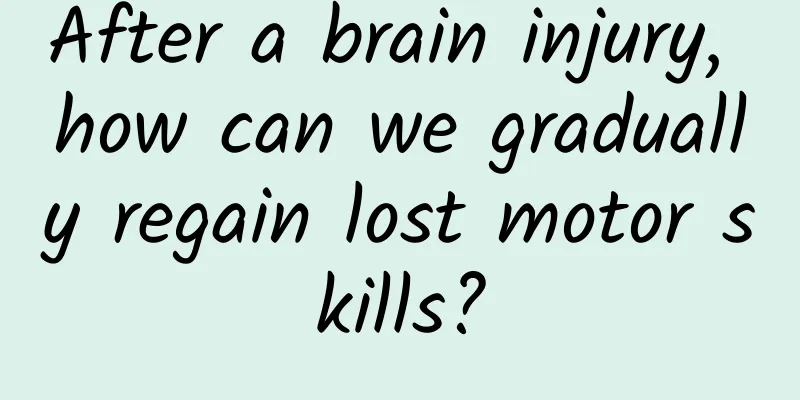After a brain injury, how can we gradually regain lost motor skills?

|
Author: Zhang Hao, Chief Physician, China Rehabilitation Research Center (Beijing Boai Hospital) Reviewer: Hu Wenli, Chief Physician, Beijing Chaoyang Hospital, Capital Medical University As a common neurological injury, brain trauma often causes patients to suffer from a variety of motor dysfunctions, seriously affecting their quality of life. Rehabilitation therapy, as an important means of recovery after brain trauma, is crucial to help patients regain the ability to take care of themselves. After a brain injury, patients often experience weakness or stiffness in their limbs, which is mainly caused by abnormal muscle tone. Muscle tone is the basis for maintaining body posture and performing various movements. After a brain injury, especially for patients with damage to the pyramidal tract, abnormal muscle tone often occurs. In the early stages, patients may show decreased muscle tone and loose limbs. At this time, family members may feel that the patient's limbs have no tension at all. However, as the recovery process progresses, muscle tone may gradually increase, manifesting as limb stiffness, and even affecting the patient's walking and daily life. Rehabilitation therapists will take appropriate measures to deal with abnormal muscle tension. For patients with low muscle tension, manual rehabilitation therapy, electrical stimulation or needle stimulation, such as acupuncture, will be used to stimulate the patient's muscles so that their muscle tension gradually returns to normal. For patients with high muscle tension, drugs that reduce muscle tension will be used, and training will be used to reduce muscle tension, including correct sitting and lying postures, to prevent excessive muscle tension from causing movement disorders. Figure 1 Original copyright image, no permission to reprint Walking function is one of the important goals of rehabilitation treatment for patients with brain trauma. For paralyzed patients, the therapist will start from the initial bed rest state and gradually train the patient's lower limb motor function until he can stand and walk. During this process, the therapist will use passive activities and induce active movements to help patients practice leg extension, leg flexion and ankle exercises to prepare for walking. After the patient has a certain degree of lower limb motor function, the therapist will begin to train the patient's standing and walking ability, paying attention to ensuring that the patient's affected limb has sufficient support and achieves alternation and balance between the left and right legs. For older patients or patients with poor functional recovery, the therapist may recommend the use of auxiliary tools such as crutches or balance bars to ensure the patient's walking safety and stability. Figure 2 Original copyright image, no permission to reprint Upper limb dysfunction is also one of the common problems in patients with brain trauma. The motor function of the upper limbs involves multiple parts such as the shoulder, elbow, wrist, and hand. For paralyzed patients, the functions of these parts may be affected. In rehabilitation therapy, therapists will train all the functions of the patient's upper limbs, including muscle strength, muscle tension, joint position, and movement patterns. For patients with limited movement of the shoulder, elbow, or wrist joints, therapists will conduct corresponding training to restore their motor function. In addition, for patients with ataxia and coordination disorders, therapists will also conduct target accuracy and stability training, such as asking patients to hold a basketball and keep it stable, or tying sandbags on their wrists to increase stability. Balance disorder is another major problem for patients with brain trauma to walk. In order to walk, patients need to have good balance. In rehabilitation treatment, the therapist will first train the patient's static balance ability so that he can stand stably. Then, gradually train the patient's dynamic balance ability, such as center of gravity shifting and stepping. For patients with severe balance disorders, the therapist may adopt a wide-base standing method, first allowing the patient to stand stably, and then gradually narrowing the distance between the two feet. In addition, the therapist will also train the patient's sitting and standing balance ability through games such as catching the ball to increase his body coordination and stability. In addition to motor dysfunction, patients with brain trauma may also have respiratory dysfunction. This may be due to brain damage affecting respiratory rhythm and breathing ability, or respiratory problems caused by tracheotomy and ventilator use. For patients with combined respiratory dysfunction, rehabilitation therapists will conduct corresponding respiratory and expectoration function training, such as using a vibrating expectorant, an expectorant, or back-patting to help patients expectorate. At the same time, therapists will also conduct breathing training to increase the patient's chest and diaphragm movement to help them expectorate more forcefully. These trainings not only help improve the patient's respiratory function, but also reduce the occurrence of lung infections and improve the patient's quality of life. |
<<: What is thyroid fine needle aspiration cytology?
>>: Brain injury recovery tips: Unlocking key skills such as breathing, vision, and self-care
Recommend
What to do if leucorrhea increases, vaginal itching and odor occurs
Many women are troubled by gynecological diseases...
What are the causes of vaginal itching in women?
The vagina is a very important reproductive organ...
Causes of brown discharge after menstruation
We know that women’s bodies are always more sensi...
Calculate the exact number of days of pregnancy
After pregnancy, many expectant mothers go to the...
Can I eat donkey-hide gelatin during menstruation?
As we all know, donkey-hide gelatin cake is a nut...
What is the difference between long-acting and short-acting insulin? Let’s find out!
The number of people with diabetes in China has i...
Can you get pregnant if you have sex before your period?
I believe that there are still many young people ...
What should I do if my lover snores? A story about obstructive sleep apnea
This is a story about why thin people snore. The ...
What are the symptoms of sleepiness during pregnancy?
Many women experience changes in their bodies dur...
What is the chance of pregnancy with a very weak positive test?
Common ways to detect pregnancy include test stri...
How to reduce fever caused by breast swelling? What to do if pregnant women have fever caused by breast swelling?
Many new mothers often experience breast engorgem...
Will a virgin bleed during ovulation?
Ovulation bleeding is related to personal constit...
Teach you how to read urine routine
Author: Chen Zhou Shanghai Changhai Hospital Revi...
Where is the mammary tissue in the breast
Women's breasts are one of the most important...
How to interpret the five-item hepatitis B report? What do big triple positive and small triple positive mean?
Author: Lou Jinli, researcher/professor at Beijin...









